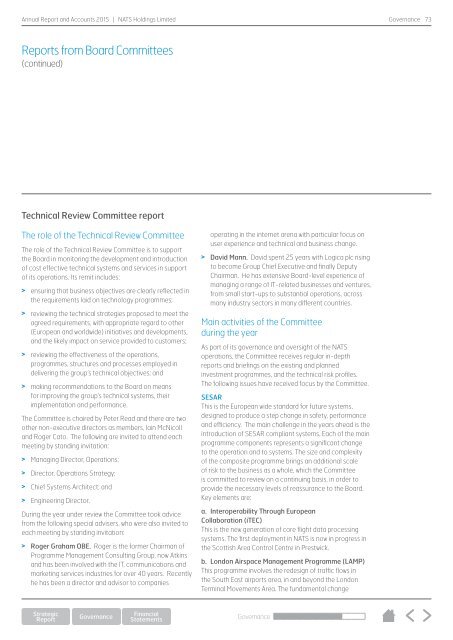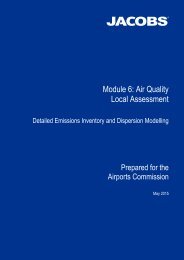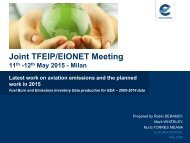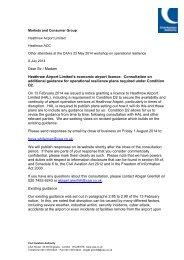NATS-Annual-Report-2015
NATS-Annual-Report-2015
NATS-Annual-Report-2015
Create successful ePaper yourself
Turn your PDF publications into a flip-book with our unique Google optimized e-Paper software.
<strong>Annual</strong> <strong>Report</strong> and Accounts <strong>2015</strong> | <strong>NATS</strong> Holdings Limited<br />
Governance<br />
73<br />
<strong>Report</strong>s from Board Committees<br />
(continued)<br />
Technical Review Committee report<br />
The role of the Technical Review Committee<br />
The role of the Technical Review Committee is to support<br />
the Board in monitoring the development and introduction<br />
of cost effective technical systems and services in support<br />
of its operations. Its remit includes:<br />
> ensuring that business objectives are clearly reflected in<br />
the requirements laid on technology programmes;<br />
> reviewing the technical strategies proposed to meet the<br />
agreed requirements, with appropriate regard to other<br />
(European and worldwide) initiatives and developments,<br />
and the likely impact on service provided to customers;<br />
> reviewing the effectiveness of the operations,<br />
programmes, structures and processes employed in<br />
delivering the group’s technical objectives; and<br />
> making recommendations to the Board on means<br />
for improving the group’s technical systems, their<br />
implementation and performance.<br />
The Committee is chaired by Peter Read and there are two<br />
other non-executive directors as members, Iain McNicoll<br />
and Roger Cato. The following are invited to attend each<br />
meeting by standing invitation:<br />
> Managing Director, Operations;<br />
> Director, Operations Strategy;<br />
> Chief Systems Architect; and<br />
> Engineering Director.<br />
During the year under review the Committee took advice<br />
from the following special advisers, who were also invited to<br />
each meeting by standing invitation:<br />
> Roger Graham OBE. Roger is the former Chairman of<br />
Programme Management Consulting Group, now Atkins<br />
and has been involved with the IT, communications and<br />
marketing services industries for over 40 years. Recently<br />
he has been a director and advisor to companies<br />
operating in the internet arena with particular focus on<br />
user experience and technical and business change.<br />
> David Mann. David spent 25 years with Logica plc rising<br />
to become Group Chief Executive and finally Deputy<br />
Chairman. He has extensive Board-level experience of<br />
managing a range of IT-related businesses and ventures,<br />
from small start-ups to substantial operations, across<br />
many industry sectors in many different countries.<br />
Main activities of the Committee<br />
during the year<br />
As part of its governance and oversight of the <strong>NATS</strong><br />
operations, the Committee receives regular in-depth<br />
reports and briefings on the existing and planned<br />
investment programmes, and the technical risk profiles.<br />
The following issues have received focus by the Committee.<br />
SESAR<br />
This is the European wide standard for future systems,<br />
designed to produce a step change in safety, performance<br />
and efficiency. The main challenge in the years ahead is the<br />
introduction of SESAR compliant systems. Each of the main<br />
programme components represents a significant change<br />
to the operation and to systems. The size and complexity<br />
of the composite programme brings an additional scale<br />
of risk to the business as a whole, which the Committee<br />
is committed to review on a continuing basis, in order to<br />
provide the necessary levels of reassurance to the Board.<br />
Key elements are:<br />
a. Interoperability Through European<br />
Collaboration (iTEC)<br />
This is the new generation of core flight data processing<br />
systems. The first deployment in <strong>NATS</strong> is now in progress in<br />
the Scottish Area Control Centre in Prestwick.<br />
b. London Airspace Management Programme (LAMP)<br />
This programme involves the redesign of traffic flows in<br />
the South East airports area, in and beyond the London<br />
Terminal Movements Area. The fundamental change<br />
Governance






